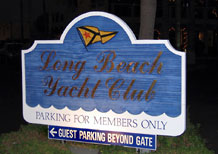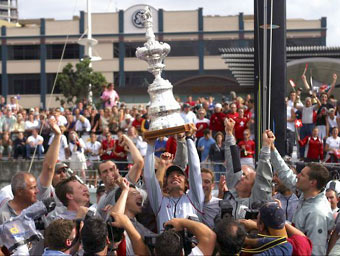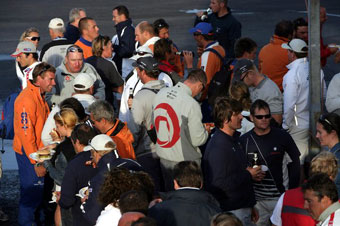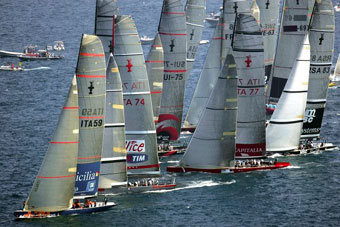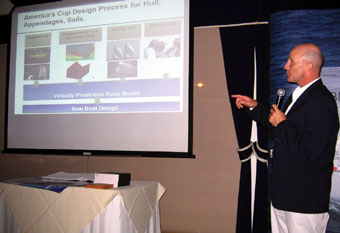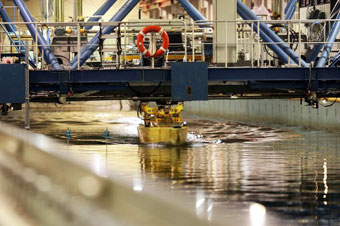|
Road Works: November 2005 |
||||||||||||||||||||||||||
Gary Jobson: Waving the Flag BMW Oracle is the only American entry in the 32nd America’s Cup, and Jobson, with BMW Oracle’s head of External Affairs and Rules Compliance, Tom Ehman, and Design Coordinator Ian "Fresh" Burns, is helping to spread the word that there is a home team to cheer for in one of the most historic sporting events in the world. The evening’s introductory commentary was vintage Jobson. "The America’s Cup is special. It makes you sit up a little straighter, makes you think about national pride. The America’s Cup has sure had an amazing ride. It’s intriguing to watch, with a multitude of surprises and nothing guaranteed – and the intrigue attracts sailors and non-sailors alike. Really, it’s a people show more than a boat show. It’s an emotional roller coaster ride," he said. And that ride is taking an entirely new turn courtesy of the defender, the Swiss entry Alinghi, and the Challenger of Record (COR), BMW Oracle Racing from San Francisco. The goal of BMW Oracle's fall yacht club tour is to generate awareness in the United States about the America’s Cup, which will be held in Valencia, Spain, and to introduce the changes the COR and Defender have made to the Cup format, including the so-called Acts, or pre-regattas, leading up to the Cup in 2007. As Jobson noted, the venerable Cup is entering a new era, and he commended BMW Oracle’s nationwide tour as a way to get the word out to sailing fans all over the country. There’s only one challenger that flies the American flag, and few share that brand of sailing pride more than Jobson. The America’s Cup has been around since 1851 – longer than the modern Olympic Games, which began in 1896. And Jobson firmly believes the America’s Cup is still the pinnacle of the sport and that there is nothing bigger than to win it, emphasizing the importance of the Cup in the world of sailing and beyond.
"The reward for winning the Cup is huge - you get to take the trophy with you, then you take the event. And if you win, not only do you generate a lot of national respect, but international respect, which I think, in the age we’re living in, would do well for this country." Also worth noting is the fact that a challenger has won four of the last seven America’s Cups. But Jobson could not resist a slight dig at the current defender. "When you think about it, the most famous mariners from Switzerland were the Swiss Family Robinson – and they shipwrecked!" Preparing to introduce the evening’s speakers, BMW Oracle's Tom Ehman and Ian Burns, Jobson highlighted the impact of the America’s Cup on technologies many sailors now take for granted. "GPS, chart plotters. My cruising boat in Annapolis has a winged keel. If Australia II hadn’t come up with wings, I don’t think I’d be driving around a shallow draft boat that has a lot of stability." Before turning the program over to BMW Oracle, Jobson had a final word about the Cup, and what it takes to succeed. "You’ve got to have the courage to take risks, try things that have never been done before, borrow ideas from other industries, anything that works." But a word of warning – fire up that TiVo, Cup fans - OLN’s coverage will come on pretty early in the morning on the West Coast! Tom Ehman: The Modern Cup Tom Ehman, BMW Oracle Racing’s rules advisor and blogmeister extraordinaire, invited the crowd to get behind the "home team," to share the team’s passion and commitment to the event. But first, what’s "New for 32?" There are four significant changes to the America's Cup format, designed to make the Cup more exciting for the fans, the media, the spectators, and most importantly, the sailors: Coherent Management - There is now a central organizing committee managing both the Challenger series and America’s Cup. Dyer Jones is the Regatta Director for the entire length of the event. Bidding the Venue - 60 cities bid for the right to host the Cup, and Valencia was chosen, in a nutshell, for the potential venue infrastructure. A Tightened Version 5.0 America's Cup Class Rule - The boats, while not one design, will be closer than ever in design parameters. Therefore, the racing should be closer than ever. With a spinnaker the size of two tennis courts and a 110-foot mast, it will be a huge sail plan on a very powerful yacht. Regular Competition - To keep interest steady between America’s Cup regattas, the idea was formed to host pre-regattas all over Europe, to help the teams ramp up and to take the Cup to as many fans as possible. These regattas are called "Acts," which as Ehman says "sounds like the marketing guys got carried away."
Ehman believes the Acts have created a new sense of camaraderie among the teams. Gone for now are the skirts, the air of secrecy, and at the "road show regattas," the large, separate team bases. An added benefit: "There were more lead changes in nine days of racing in Trapani than in the entire 31st America’s Cup," said Ehman.
Enhancements Gate Marks – A gate requires the teams to address an entirely new set of decisions by the afterguard – which gate is the least difficult, which side is favored, which is the best passing lane for the trailing boat. So rather than the standard "parade," boats will have a greater opportunity to pass. Shorter Distance Courses – The race courses in the Acts are 12 miles long, which is half the distance of Newport, 3/4 the distance of Auckland. The teams will have two races a day to challenge the stamina of the sailors. Fleet Racing Format - For the first time since 1870, fleet racing is back in the America’s Cup. The result has been pretty exciting. "Match racing is tactically much more challenging, much more difficult, but fleet racing is frankly more fun. It’s visually more spectacular, the fans like it – and the sailors like it," said Ehman. Ehman is encouraged by the reaction from European fans, pointing to the fact that instead of a five-year gap between Cups, there’s continued racing and continued interest.
"It’s a brave new America’s Cup. The key line in the Deed of Gift is 'a friendly competition between foreign countries,' and I’ll guarantee you we’ve got more competition than ever, it’s friendlier than ever, and there are more countries than ever – a record 12 teams from 10 countries, including first-timers from China, Germany and South Africa," he said. With that in mind, Ehman expects an exciting 32nd America’s Cup – with an eye toward the 33rd. "The mission is very clear – to lift the burden of holding the Cup from the defender. We have 132 members from 16 countries, and we are very proud to be the only team representing the U.S. If we win, Larry Ellison is on record as saying we will bring the Cup to San Francisco Bay." Fresh Burns: Design Ehman turned the mike over to designer Burns, but not before giving an explanation for Burns' nickname "Fresh." "Ian was an early morning milk delivery boy in Sydney – hence, ‘Fresh!’" According to Burns, there are two ways to go faster: decrease drag and/or increase thrust. The team is looking for a 5 percent advantage, the kind of testing you find "down in the noise."
"The rule changes make the boats better in lighter winds. They’re lighter, with more sail area and more draft. The old boats weighed 25 metric tons – these weigh 24. The draft is 4.1 meters deep. And there’s only a 2-inch variation allowed in the length," he said. Translation: It will be up to the design team to find that small something that someone else didn’t think of, to make the boat faster, to help the team work with the boat better. And money will not necessarily be the deciding factor. "It’s not how much you spend," said Burns. "It’s what you spend the money on." BMW Oracle has their design team spread all over the world, handling the many different aspects involved in putting an America’s Cup yacht together. There are three main areas – structures, aerodynamics and hydrodynamics. There are design activities are centered in several primary locations: Seattle – using the aerospace engineering infrastructure to come up with new ideas. The boats will be built in Seattle. San Francisco – using resources from Ellison’s Oracle Corp. to back up the plethora of data information coming to and from the boats. Annapolis – the main design center. Newfoundland – the only large-scale tank testing facility available in North America. The rules do not require the team to test in the US, and there are no sailing tanks left in the US of this size. The US Navy controls most of the towing tanks now, and they are all power based. Auckland – building the sails and the mast. Munich – making use of BMW’s F1 engineers. Valencia – the balance of the sailing and design team.
BMW Oracle begins the design process with experiments in the computer employing Computational Fluid Dynamics (CFD) to look at every aspect of the boat’s movement through the water, working up to large-scale models of approximately 27 feet long. As the team tests different combinations of sails and boat changes, massive amounts of data stream off the boat into a computer that turns all the data into one single number. That number essentially shows what worked or didn’t work. Then it’s down to perceptions. Does the sailing team like how the changes feel? Do they work in practice as well as in theory? Every single aspect of the boat, from rig to keel to deck layout, will get a thorough look before the first boat is built. The team is naturally cagey about the timing of the new boats – all Burns will admit to is that Boat Number One will be started "soon," with the second boat depending on the look of the initial new boats from the competition. The team will build 20 to 22 models, at US $250,000 each. (If you’re wondering, 25 to 30 percent of the team’s budget will be spent on design.) Costs are relative. Both the materials and the methods for constructing the boat and the mast are strictly regulated to help manage costs. The sails, however, are under a much more flexible rule, and are allowed more freedom in their design. But with flexibility comes expense - a jib sheet can last a regatta, but a genoa survives only 60 tacks, which works out to $500 to $1,000 per tack. Given that kind of consumable expense, the sails are monitored closely by the team during testing. Cameras are mounted on the mast to record sail movements and angles. The Version 5.0 rule, Burns feels, will undoubtedly mean fairly conventional packages from the competitors, with no one likely to attempt to "hit one out of the ballpark" on design. Burns summed up the BMW Oracle design philosophy as they head into the final stretch of boat design: "The ideal design is achieved by combining the crew’s vision with technical excellence. We’re looking for that one small advantage that will make the difference between winning and losing the Cup." --by Diane Swintal. ©2005 CupInfo
BMW Oracle Racing
Team Site |
|
